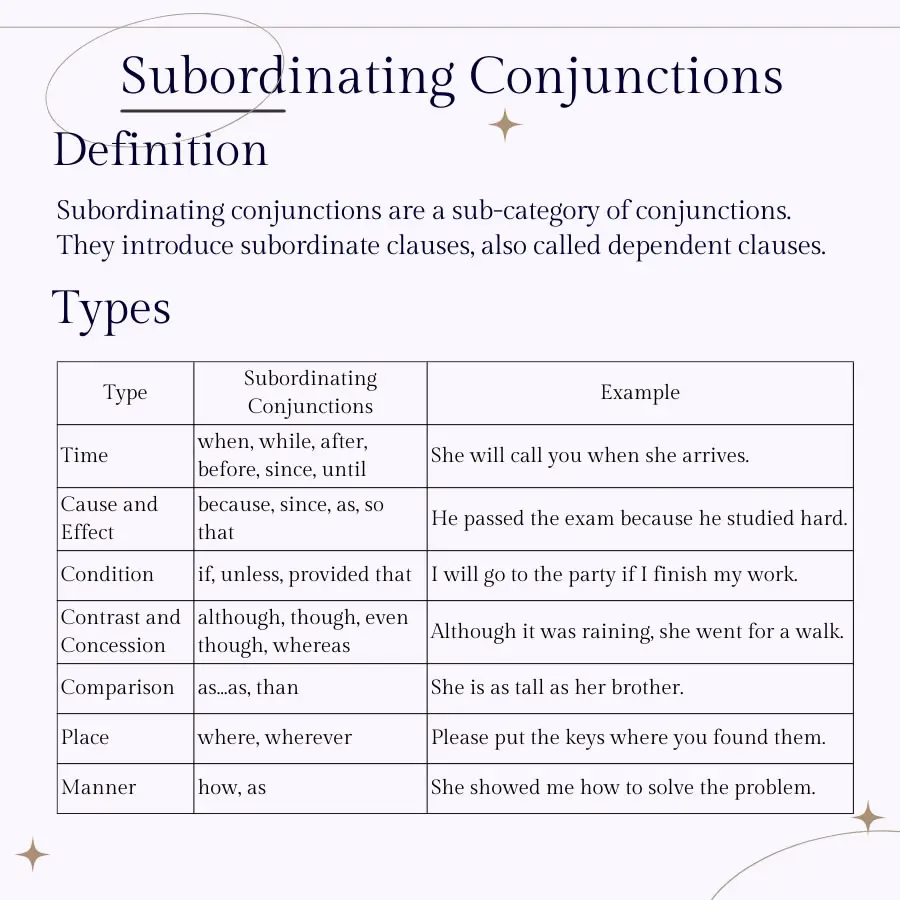Conjunctions and Subordinating Conjunctions
Conjunctions connect different parts of a sentence. These can be words, phrases, or clauses. Subordinating conjunctions, a specific type of conjunction, introduce dependent clauses, adding complexity and depth to sentences. In this article, we will delve into the differences between conjunctions and subordinating conjunctions, how to identify them, their usage, and common misconceptions.
Table of Contents
What are conjunctions?
Conjunctions are words that connect words, phrases, or clauses in a sentence. They serve to establish relationships between different parts of speech, making the sentence flow smoothly and coherently.
Types of conjunctions
There are three main types of conjunctions:
- Coordinating conjunctions
- Subordinating conjunctions
- Correlative conjunctions
Conjunctions and Subordinating Conjunctions
As mentioned above, subordinating conjunctions are a subcategory of conjunctions. When used to combine parts of a sentence, they serve to link dependent clauses to main clauses, creating complex sentences.
In the upcoming sections, we will specifically explore subordinating conjunctions.
Subordinating Conjunctions
Subordinating conjunctions are a sub-category of conjunctions. They introduce subordinate clauses, also called dependent clauses. Examples of subordinating conjunctions include: “because,” “if,” “when,” “although,” “while,” “since,” “until,” and “before.”
Definition
Subordinating conjunctions introduce subordinate clauses, which cannot stand alone as complete sentences. They establish a relationship of dependence between the subordinate clause and the main clause.
Examples:
- When: She will call you when she arrives.
- Since: He has been working from home since last March.
- Where: Please put the keys where you found them
Subordinating Conjunction Examples
Here are some examples of subordinating conjunctions::
- Because he studied hard, he passed the exam.
- I will go for a walk if the weather improves.
- She will sing whenever she feels happy.
- Although it was raining, she went for a walk.
Here is a table that explains the relationships between the different parts of a sentence that contain a subordinating conjunction.
| Main Clause | Subordinating Conjunction | Subordinate Clause |
|---|---|---|
| He passed the exam | Because | he studied hard |
| I will go for a walk | if | the weather improves |
| She will sing | whenever | she feels happy |
| She went for a walk. | Although | it was raining |
7 Types of Subordinating Conjunctions

There are various types of subordinating Conjunctions:
1. Time
Subordinating conjunctions indicating time:
- when: It refers to a specific point in time.
- Example: I will call you when I arrive home.
- while: It indicates something happening during the same time as something else.
- Example: She likes to listen to music while she works.
- after: It indicates something happening following another event.
- Example: He went to bed after he finished his homework.
- before: It indicates something happening prior to another event.
- Example: Please wash your hands before you eat.
- since: It indicates something happening from a specific time until the present.
- Example: She has been working from home since last March.
- until: It indicates something happening up to a certain point in time.
- Example: You can stay up until midnight.
2. Cause and Effect
Subordinating conjunctions indicating cause and effect:
- because: It introduces the reason for something.
- Example: She went to bed early because she was tired.
- since: It indicates the reason or cause for something, often focusing on a duration.
- Example: Since it was raining, we stayed indoors.
- as: It denotes the reason or cause, often used in formal writing.
- Example: As it was getting late, we decided to leave.
- so that: It expresses purpose or intent, indicating the reason for an action.
- Example: She studied hard so that she could pass the exam.
3. Condition
Subordinating conjunctions indicating condition:
- if: It introduces a condition that must be met for something else to happen.
- Example: If it rains, we will stay indoors.
- unless: It introduces a condition that must be fulfilled for something else not to happen.
- Example: She won’t go out unless it stops raining.
- provided that: It indicates a condition that must be met for something else to occur.
- Example: You can go out, provided that you finish your homework first.
4. Contrast and Concession
Subordinating conjunctions indicating contrast or concession:
- although: It introduces a contrast or concession between two clauses.
- Example: Although it was raining, she went for a walk.
- though: It has the same function as “although,” but it is less formal.
- Example: Though it was cold, he didn’t wear a coat.
- even though: It emphasizes a strong contrast or concession.
- Example: Even though she studied hard, she failed the exam.
- whereas: It introduces a strong contrast between two clauses.
- Example: He likes coffee, whereas she prefers tea.
5. Comparison
Subordinating conjunctions indicating comparison:
- as…as: It indicates the degree of similarity between two things.
- Example: He is as tall as his brother.
- than: It introduces the object of comparison.
- Example: She is taller than her sister.
6. Place
Subordinating conjunctions indicating place:
- where: It refers to a specific location.
- Example: She left her keys where she found them.
- wherever: It indicates any location.
- Example: You can sit wherever you like.
7. Manner
Subordinating conjunctions indicating manner:
- how: It introduces the way or manner in which something is done.
- Example: She showed me how to solve the problem.
- as: It has a similar function to “how,” often used in formal writing.
- Example: She did it as she was told.
8. Purpose
Subordinating conjunctions indicating purpose:
- so that: It introduces the purpose or intention of an action.
- Example: She studied hard so that she could pass the test.
- in order that: It has the same function as “so that,” but it is more formal.
- Example: She arrived early in order that she could find a good seat.
Here is a summary of the above subordinating conjunctions in a table:
| Type | Subordinating Conjunctions | Example |
|---|---|---|
| Time | when, while, after, before, since, until | She will call you when she arrives. |
| Cause and Effect | because, since, as, so that | He passed the exam because he studied hard. |
| Condition | if, unless, provided that | I will go to the party if I finish my work. |
| Contrast and Concession | although, though, even though, whereas | Although it was raining, she went for a walk. |
| Comparison | as…as, than | She is as tall as her brother. |
| Place | where, wherever | Please put the keys where you found them. |
| Manner | how, as | She showed me how to solve the problem. |
Comma in Subordinating Conjunctions
When using subordinating conjunctions to connect subordinate clauses to main clauses, the use of commas depends on the position of the subordinate clause in the sentence.
Comma before the Subordinating Conjunction
When the subordinate clause comes before the main clause, it is usually followed by a comma. This comma helps to signal the beginning of the subordinate clause and clarify the structure of the sentence.
Example:
- Before she went to bed, she brushed her teeth.
No Comma after the Subordinating Conjunction
When the subordinate clause comes after the main clause, a comma is generally not used after the subordinating conjunction. In this case, the subordinating conjunction seamlessly connects the two clauses without the need for a comma.
Example:
- She brushed her teeth before she went to bed.
Exceptions
However, there are exceptions to these guidelines. If the subordinate clause is very short and closely related to the main clause, a comma may be omitted even when the subordinate clause comes first.
Example:
- She smiled when she saw her friend.
In this case, the subordinate clause “when she saw her friend” is short and closely connected to the main clause “She smiled.” Therefore, no comma is needed.
Using Commas for Clarity
In complex sentences or when the subordinate clause contains additional information, the use of commas can improve clarity.
Example:
- After finishing her homework, she went for a walk.
Here, the comma after “After” helps to separate the subordinate clause “finishing her homework” from the main clause, making the sentence easier to understand.
Conclusion
In conclusion, subordinating conjunctions connect dependent clauses to main clauses, thus forming complex sentences. In this article, we have explored various types of subordinating conjunctions, each serving a specific function in sentence structure. From indicating time and cause to expressing conditions and contrasts, subordinating conjunctions offer diverse ways to link ideas.
It is important to pay attention to punctuation when using these conjunctions, ensuring clarity and coherence in writing.


